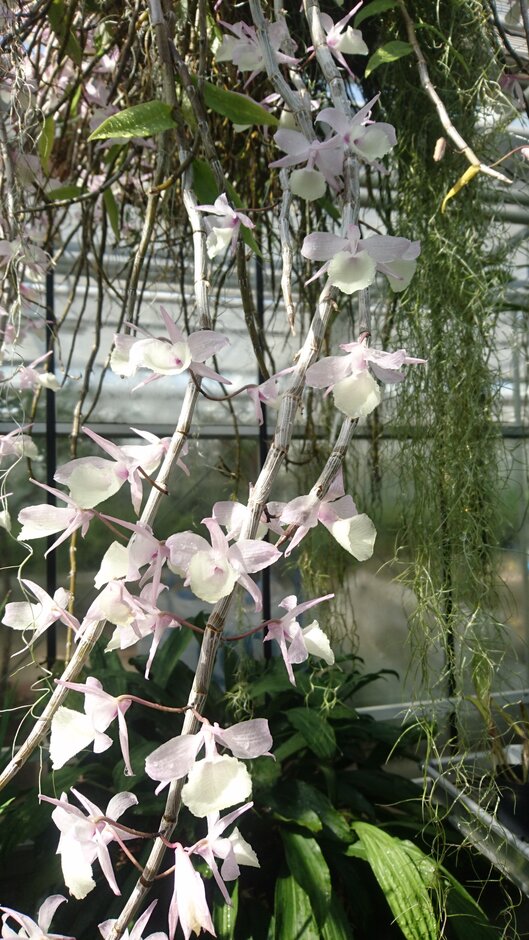Dendrobium aphyllum
hooded orchid
A large-sized, deciduous, epiphytic orchid with pendulous, cane-like stems, 60-80cm long and 0.5cm thick. Each noded stem carries alternate, bright green, glossy, lance-shaped leaves, 6-8cm long and 2cm wide. Short flowering stems, carrying one to three flowers, appear from the nodes along leafless stems in winter and spring. Each flower is approximately 4cm large, fragrant and fairly short-lived. Petals and sepals are usually pale pink, with large, rounded, or slighly pointed white lip, with hairy edge.

Size
Ultimate height
0.5–1 metresTime to ultimate height
5–10 yearsUltimate spread
0.5–1 metresGrowing conditions
Moisture
Well–drainedpH
NeutralColour & scent
| Stem | Flower | Foliage | Fruit | |
| Spring | Pink White | Green | ||
|---|---|---|---|---|
| Summer | Green | |||
| Autumn | Green Yellow | |||
| Winter | Pink White |
Position
- Full sun
- Partial shade
Aspect
East–facing or West–facing or South–facing
Exposure
Sheltered Hardiness
H1ABotanical details
- Family
- Orchidaceae
- Native to GB / Ireland
- No
- Foliage
- Deciduous
- Habit
- Clump forming, Pendulous weeping
- Genus
Dendrobium are epiphytic and terrestrial orchids with elongated, stem-like pseudobulbs bearing linear to ovate leaves. Racemes or panicles of showy flowers are produced from nodes along the stems mainly in spring
- Name status
Correct
- Plant range
- SE Asia
How to grow
Cultivation
Plants are best grown in basket or mounted on cork bark or wood if grown in conditions where sufficient humidity can be provided during the growing season. Grow in an epiphytic, medium grade, bark-based potting mix with added perlite, moss, or coir. As with many orchids, they grow best when the roots are slightly restricted. Therefore, avoid over-potting or frequent root disturbance. Provide bright, filtered light throughout the year. Plant requires frequent watering and relatively high humidity during summer months and a period of rest in winter - reduce watering and feeding in October, until warmer temperatures initiate flowering and new growth in spring. See indoor orchid cultivation
Propagation
Propagation by seed is only possible in controlled laboratory environment. Mature plants may be divided when the plant overgrows the pot. Sideshoots (keiki) may develop on older canes - remove and pot them into sphagnum moss when the new roots are at least 2cm long.
Suggested planting locations and garden types
- Houseplants
- Conservatory and greenhouse
Pruning
No pruning required. Remove spent flowers as necessary, but do not cut the whole cane unless completely shrivelled. Oldest canes may be removed as long as there are at least three, younger, thick, leaf-bearing canes on the plant.
Pests
May be susceptible to scale insects, aphids, mealybugs and red spider mite.
Diseases
Generally disease-free.
Get involved
The Royal Horticultural Society is the UK’s leading gardening charity. We aim to enrich everyone’s life through plants, and make the UK a greener and more beautiful place.